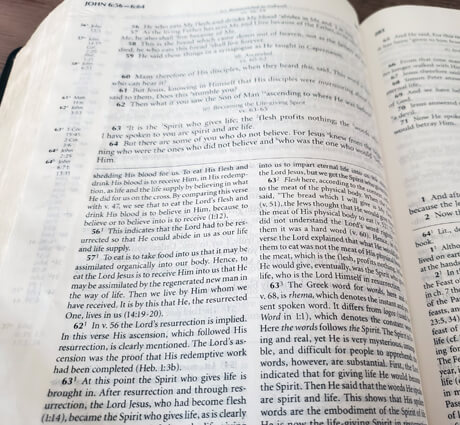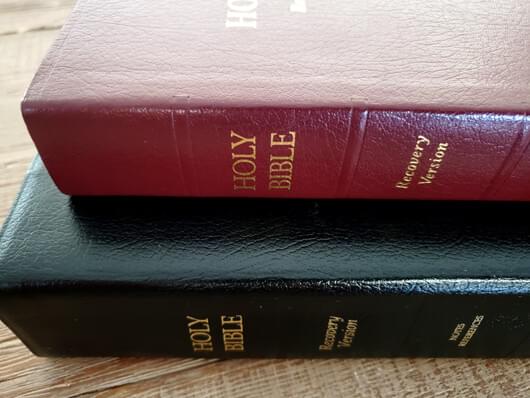The third purpose of the footnotes is to help us to solve the common and hard problems in the New Testament. In nearly every book of the New Testament there are some questions that are hard to answer and some problems and points that are hard to understand. The footnotes in the Recovery Version are an attempt to solve the hard problems in the Bible in order to help the readers get through them. (Elders’ Training, Book 3: The Way to Carry Out the Vision, ch. 9 [CWWL, 1984, 2:310])
Many readers of the Bible have encountered portions of the New Testament that are challenging to understand or that raise difficult questions that prevent them from understanding the Bible clearly. Sometimes these readers are able to progress in their reading despite the challenges, but it is more often the case that they are halted and even become stuck in their attempt to understand those passages.
In a meeting with some responsible brothers in the local churches, Brother Lee related his own experience of becoming stuck while studying the Bible:

I had much experience as a young man studying the Bible. I came to a certain point in the Bible that I could not understand, and I became stuck on that point. For instance, 2 Peter 2:4 refers to the gloomy pits to which the angels who sinned were delivered. When I read this as a young man in the Chinese version of the Bible, I got stuck on this point. I did not know what the Chinese meant by gloomy pits. In the Recovery Version, however, there are adequate footnotes to help on problems such as these. (Elders’ Training, Book 3: The Way to Carry Out the Vision, ch. 9 [CWWL, 1984, 2:310])
Brother Lee’s burden to help the Lord’s seekers enter into the truths of the Bible and, in part, the difficulties that he encountered in learning the Bible caused him to spend much time consulting commentaries, dictionaries, lexicons, concordances, and other reference books in order to produce the notes in the Recovery Version that could help solve the difficult problems in the study of the Word. The result of that labor is that the Holy Bible Recovery Version with its notes provides a proper interpretation of many difficult-to-understand points in the Bible and gives the reader the way to progress not only in reading and enjoying the Word of God but also in understanding and apprehending the divine revelation.
The result of that labor is that the Holy Bible Recovery Version with its notes provides a proper interpretation of many difficult-to-understand points in the Bible and gives the reader the way to progress not only in reading and enjoying the Word of God but also in understanding and apprehending the divine revelation.
Another instance of a difficult problem in the study of the Bible occurs in 1 Peter 3, where Peter writes concerning Christ’s suffering for righteousness by the will of God. In verses 18 through 20 Peter states: “Christ also has suffered once for sins…on the one hand being put to death in the flesh, but on the other, made alive in the Spirit; in which also He went and proclaimed to the spirits in prison, who had formerly disobeyed when the long-suffering of God waited in the days of Noah.” The difficulty in these verses pertains to whom the spirits in prison refers to. Some have argued that it refers to the spirits of dead human beings, others that it refers to angels, and yet others that it refers to demons. We can easily become sidetracked by trying to understand this passage on our own. However, a footnote on this phrase in the Recovery Version helpfully explains:
Throughout the centuries great teachers of different schools have had varying interpretations concerning the spirits in prison. The most acceptable according to the Scriptures is as follows: the spirits here refer not to the disembodied spirits of dead human beings held in Hades but to the angels (angels are spirits—Heb. 1:14) who fell through disobedience at Noah’s time (v. 20 and Life-study of Genesis, Message Twenty-seven, pp. 363-4) and are imprisoned in pits of gloom, awaiting the judgment of the great day (2 Pet. 2:4-5; Jude 6). After His death in the flesh, Christ in His living Spirit as His divinity went (probably to the abyss—Rom. 10:7) to these rebellious angels to proclaim, perhaps, God’s victory, accomplished through His incarnation in Christ and Christ’s death in the flesh, over Satan’s scheme to derange the divine plan.
This footnote acknowledges the various interpretations of the spirits in prison, helps identify which is most acceptable based on Scripture, and supplies the relevant Scripture references in the presentation of that interpretation. Furthermore, it places the preferred interpretation in the context of Peter’s speaking and God’s eternal plan. Once a person reads this footnote, it is evident to whom the spirits in prison refer, and the reader is able to get through this point and make progress in the study of the Word.
Yet another difficult passage in the New Testament that has troubled many believers is the “hard” saying in John 6:51-59. Specifically, verses 53 and 54 say “Truly, truly, I say to you, Unless you eat the flesh of the Son of Man and drink His blood, you do not have life within yourselves. He who eats My flesh and drinks My blood has eternal life, and I will raise him up in the last day. For My flesh is true food, and My blood is true drink.” This speaking concerning eating the Lord’s flesh and drinking His blood to have eternal life stumbled some of His disciples when He spoke it, and today it remains difficult for many readers of the New Testament. However, the footnotes in the Recovery Version help the reader resolve the apparent controversy by pointing out the meaning of the Lord’s word based on the context in John 6 and John’s gospel as a whole.
A footnote on the word flesh in verse 54 explains that by comparing verse 54 with verse 47 in John 6 “we see that to eat the Lord’s flesh and drink His blood is to believe in Him, because to believe or to believe into is to receive” as stated in John 1:12. Three other footnotes in the chapter help to fully explain the Lord’s word in these verses as well as to lead the reader into the proper experience of receiving the resurrected Lord as life and life supply (note 1 on John 6:57 and notes 1 and 2 in John 6:63).

Lastly, one of many common problems that the footnotes in the Recovery Version help the believers through pertains to the security of salvation. Many believers throughout the ages have been troubled about whether or not the divine life and salvation that they have received can be lost. On the one hand, the Lord states clearly in verses such as John 10:28-29: “I give to them eternal life, and they shall by no means perish forever, and no one shall snatch them out of My hand. My Father, who has given them to Me, is greater than all, and no one can snatch them out of My Father’s hand”; on the other hand, there is sometimes a need for further guidance so that the reader can understand the implications of the Lord’s speaking in Scripture. In this case, the footnote on eternal life in the Recovery Version provides that needed guidance. It states:
Eternal life…is for the believers’ living. The Father’s hand, by which He chooses in His love according to His purpose (17:23; 6:38-39), and the Son’s hand, by which He saves by His grace for the fulfillment of the Father’s purpose (1:14; 6:37), both of which have the keeping power, are for the believers’ protection. Eternal life will never run out, and the hands of the Father and the Son will never fail. Hence, the believers are eternally secure and will never perish. (Note 1 on John 10:28)
The three examples above are a sampling of some of the footnotes in the Recovery Version that illustrate its third purpose—to solve the common and hard problems in the New Testament. There are many more notes of this nature in the Recovery Version. Any readers seeking to make progress in the study of the Bible and in fully apprehending its meaning should avail themselves of the help that the Recovery Version with its footnotes provides.

Living Stream Ministry now has an app for the Recovery Version. View more details about this app or download it from one of the app stores below:
eBooks Available for Purchase:
Print Editions Available for Purchase: